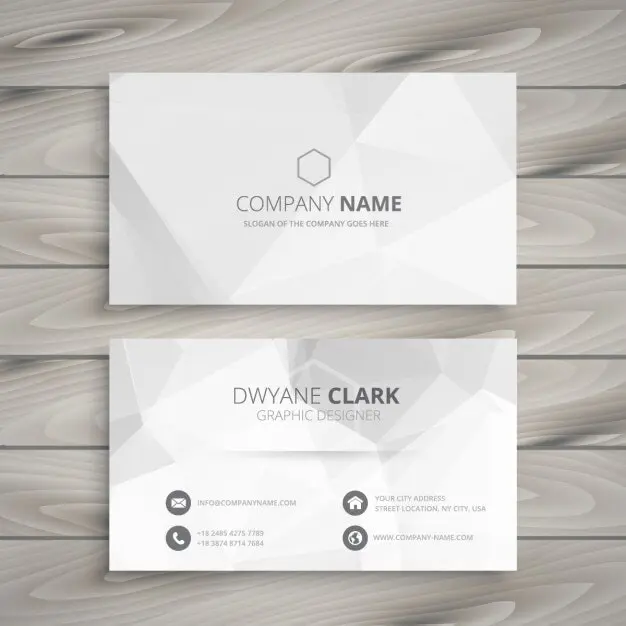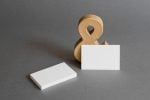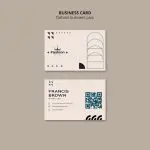You’re about to make a mistake that could cost you thousands in lost opportunities. It’s not your pitch, your product, or even your pricing. It’s something far more fundamental: your business card size.
Think I’m exaggerating? Consider this: In the split second it takes someone to glance at your card, they’ve already formed a lasting impression of your entire business. Get it wrong, and you might as well have handed them a ticket to your competitor.
But here’s the twist: The “perfect” business card size isn’t what you think. Forget the cookie-cutter advice you’ve heard before. The truth about paper business cards is, that your ideal dimensions depend on factors most people never even consider.
I’ve seen CEOs fumble million-dollar deals because their cards didn’t fit standard wallets. I’ve watched startups skyrocket to success with cards that broke every rule in the book. The difference? They understood the psychology behind size choices.
This isn’t just about measurements. It’s about the silent message your card sends before you even open your mouth. It’s about standing out in a sea of 3.5 x 2-inch rectangles. It’s about making every millimeter count.
So, are you ready to discover the size secrets that separate forgettable, folded business cards from unforgettable first impressions? Buckle up. We’re about to dive into a world where fractions of an inch can make or break your business. And trust me, by the end of this guide, you’ll never look at a business card the same way again.
Boost customer satisfaction with just a few clicks
Most-Loved Features:
- On-demand drivers
- Real-time GPS tracking
- Delivery confirmation photos
- Over 50% of customers report a smoother delivery experience
Understanding Standard Business Card Dimensions
-
Business cards are 3.5 x 2 inches (88.9 x 50.8 mm). They fit snugly in wallets.
-
Europe uses 85 x 55 mm cards. Consider this for cross-border printing.
-
Print quality relies on resolution. Bleed areas and margins matter.
Step 1: Know the Standard Dimensions
Business cards are a staple in professional networking. The standard size for print business cards in the U.S. is 3.5 x 2 inches (88.9 x 50.8 mm). This dimension allows them to fit easily into wallets and standard cardholders. This ease of handling often makes this size the default choice among professionals. Despite technological advancements like digital business cards, the traditional printed card still holds strong due to its tactile impact and effectiveness.
Step 2: Consider Metric Alternatives
While 3.5 x 2 inches is standard in the U.S., the European standard is different. European business cards typically measure 85 x 55 mm. This size variation can have implications for international businesses. Beyond the different dimensions, the design approach for rounded corner business cards may differ to accommodate this slightly larger scale. The reason for differing sizes often stems from regional preferences and traditions in business interactions.
Step 3: Printing Considerations for Standard Size
When designing a business card, paying attention to printing details is critical. A ‘bleed’ is an area that extends beyond the card to ensure the background reaches the edge without leaving white lines. Ignoring this detail can lead to unattractive borders when the card is cut. Additionally, keeping important text and logos within ‘safe zones’ ensures they won’t be cut off. It’s also vital to ensure high-resolution images are used to maintain a professional appearance.
Exploring Business Card Size Variations
-
Vertical cards offer unique design options.
-
Square cards provide creative yet compact dimensions.
-
Oversized and mini cards cater to different branding needs.
Step 1: Vertical Business Cards
Vertical business cards maintain the standard 3.5 x 2 inches but stand out due to their portrait orientation. This simple shift in orientation changes how the information is perceived. Designers often use vertical layouts to create a sense of elegance or modernity. This is because such layouts draw the eye from top to bottom, providing a clear, linear flow of information.
However, there are some design challenges with vertical cards. They may not fit traditional cardholders. Adjusting the design elements can improve readability. For instance, circle business cards, and aligning text and graphics vertically can make a big difference.
Addressing the common question, the size of a vertical business card with bleed usually extends to 3.625 x 2.125 inches. This accommodates the bleed area, ensuring your design reaches the card’s edge without any blank lines.
The standard vertical ID card size, however, is typically larger, around 3.375 x 2.125 inches. It’s essential to differentiate these from business cards since different shapes of ID cards serve different purposes and formats.
Step 2: Square Business Cards
Square business cards offer a distinctive look. Common sizes are either 2.5 x 2.5 inches or 2 x 2 inches. These shapes and non-traditional dimensions act as conversation starters, making them suitable for creative industries keen on making a strong first impression.
Design possibilities with square cards are boundless, but they come with their own challenges. The confined space limits how much information you can include. This necessitates a thoughtful layout. Minimalism can be effective here—think of strategic use of color and concise text.
One benefit of square cards is their symmetry, which can increase visual appeal. However, they may not fit conventional cardholder slots seamlessly, thus affecting their practicality in professional settings.
Step 3: Oversized and Mini Cards
Oversized Business Cards
Oversized standard business cards, generally sized at 3.5 x 4 inches, offer more room for graphics and text. This extra space allows for detailed company information, making them ideal for businesses with complex branding messages. However, they might not fit in standard wallets, challenging their convenience.
Oversized cards excel in visual storytelling, thanks to the additional space. Consider using high-resolution images or detailed illustrations to captivate recipients. Be aware, though, that higher production costs might accompany the larger dimensions.
Mini Business Cards
Mini cards measure around 2.75 x 1.1 inches. They suit brands with minimalist approaches. Their tiny size demands precise, impactful design. By focusing only on essential elements of standard business cards stand like logo and contact details, mini cards retain a clean and sleek appearance.
Yet the limited space on greeting card restricts how much information you can present, necessitating creative use of negative space. These cards often serve niche markets or personal branding projects, where simplicity is a key design driver. To make an impact, utilizing innovative designs can be crucial. Consider exploring various business card template ideas that can help you stand out with style. A well-thought-out template not only enhances your card’s aesthetic but also ensures that it communicates your message effectively. Discover some creative approaches and inspirations for your business card design.
With these variations explored, you’ll be well-prepared to start designing business cards that leave a lasting impression on potential customers without being confined to traditional formats.
Designing Custom Business Cards for Impact
-
Highlight key details for prominence.
-
Use a readable font without clutter.
-
Graphics should match your brand.
Step 1: Prioritize Key Information
Start by organizing the most important details. Ensure your name and contact information are clear. These are the details people look for first. Lay them out in a clean, readable format. Your company logo adds instant recognizability. Place it where the eye goes upon first glance, perhaps the top left or center. Also, include a tagline if your brand has one. This small snippet tells others what your business is about. Limit additional text. Too much information can clutter the card and dilute its impact.
Step 2: Choose the Right Font Size
Using the correct font size is all about balance. A font size between 10 pt and 12 pt works best for readability. Anything smaller can be hard to read, especially for contact details. If it’s larger, your card could look unbalanced. These sizes maintain clarity without dominating the card. White space is your friend here. It prevents your card from looking cramped. It ensures each piece of information stands out.
You should select fonts that are simple and professional. Fonts with clean lines work well to convey a modern feel. Decorative fonts might look interesting but can be hard to read. It is better to avoid mixing too many fonts; stick to one or two. This keeps your design cohesive.
Step 3: Select Supportive Design Elements
Colors convey emotions and messages. Choose colors that reflect your brand. If your company’s branding relies on blues and greens, stay consistent. This strengthens brand recognition. Contrast also plays a key role. Ensure text contrasts against the card’s background. This makes it easy to read.
Graphics can enhance your card. They’re great for showing creativity or professional flair. But you should make sure they don’t overshadow essential details. Simple icons can point to information like email or phone numbers. You should use images with a resolution of 300 dpi for sharpness, as recommended by WP Engine.
Ensure Cohesion of Design
All elements should feel like they belong together. This means fonts, colors, and images should create a unified look. If you’re ever in doubt, opt for simplicity. A clean and professional card is always effective.
Step 4: Leverage Material and Finish
The paper choice affects the card’s feel. The thicker paper stock feels premium compared to thinner alternatives. Different finishes add different effects. A matte finish delivers a smooth and sophisticated texture. While gloss makes colors pop, attracting attention. Unique materials like recycled cardstock can also suggest eco-friendliness.
For impactful finishes, experimenting with embossing or foil stamping can add a tactile appeal. This enhances textures and highlights specific elements without needing extra visual clutter. Remember these could drive costs up, but they certainly make an impression.
Step 5: Double-Check Your Design
Before printing, proofread everything. Check the layout for mistakes and adjust as needed. A small mistake can render the card ineffective. Consider asking a colleague for feedback. They might spot something you’ve overlooked. Ensuring high resolution and good color reproduction is important for the final output.
Choosing the Right Business Card Size
-
Find the best size for your business needs.
-
Reflect your brand’s image through size.
-
Test before doing a big print order.
Step 1: Assess Practical Needs
Compare Standard vs. Variations in Your Industry
Understanding what is common in your field can help choose the right card size. If most of your competitors use standard sizes, sticking with that might be best. But if your industry leans towards creativity, a unique size could stand out. Grab some examples from your peers and analyze the dimensions they choose. Going against the norm can be impactful if you do it thoughtfully.
How Environment and Use Affect Choices
Consider how and where your business card will be used. This includes whether it will be shared at formal meetings, creative events, or displayed in a cardholder. For instance, if your cards often sit in cardholders or wallets, standard sizes work best to ensure convenience. Conversely, if you’re in the creative field, a non-standard size might prompt further engagement. You should think practically about the day-to-day use of your business card design too. Uncover why the design and practicality of your company’s calling card are vital in making a lasting impression in the modern corporate landscape.
Step 2: Align with Brand Identity
Consistency with Other Marketing Materials
Your standard business card size should match your brand’s other marketing materials. This means ensuring your business card does not feel out of place. Think about brochures, letterheads, and even your website. They all should feel like they belong together. This consistency can reinforce your brand image.
Brand Perception and Customer Expectations
Consider how your card size impacts your brand image. Small cards can feel minimal and sleek, which might suit a tech startup. Oversized cards might work for a luxury brand looking to leave a lasting impression. Reflect on your customer base and their expectations of your brand. Would they appreciate a traditional approach, or is innovation more aligned with their view of your brand?
Step 3: Test and Iterate Designs
Getting Feedback from Peers or Clients
It is better to create several prototypes of your standard business card sizes. Present these to trusted peers or clients. Gather their thoughts on size, practicality, and design. These insights are invaluable. They can show if a card size is too unwieldy or impressionable.
Testing with Small Batches Before a Large Print Run
You should start with a small print run once you’ve settled on a design. This helps you see how the card feels and functions in real life. Distribute these among a select group of customers, and observe any issues or compliments received. This phase helps prevent costly errors when moving to a larger order.
Your Business Card, Your Brand Story
Business cards are more than paper rectangles; they’re your brand’s handshake. From standard 3.5 x 2 inches to bold squares and minis, each size tells a unique story. Your choice reflects not just practicality, but your brand’s personality. Remember, a well-designed card speaks volumes before you say a word. It’s the silent ambassador of your business, working long after you’ve left the room. Explore how a creative and impactful calling card can set you apart in a crowded market, underscoring why it’s an indispensable tool in your branding arsenal.
As you craft your perfect business card, think beyond size. Consider how it feels in your hand, how it catches the eye, and how it represents you. Will it be remembered, or lost in a sea of sameness? Your own business card is a canvas for creativity, a testament to your attention to detail, and a preview of the value you offer.














